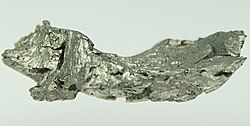For faster navigation, this Iframe is preloading the Wikiwand page for
Gadolinium .
Gadolinium, 64 ngoi-kôn
silvery white Kî-pún sin-sit Miàng, fù-ho
Gadolinium, Gd ngoi-hìn
silvery white Gadolinium chhai chû-khì-péu ke vi-chi
ngièn-chṳ́ sì-sú
64 ngièn-chṳ́-liòng (±)
157.25(3)[1] ngièn-su lui-phe̍t
lanthanum-hi Chhu̍k, fûn-khî
n/a , f-block chû-khì
period 6 thien-chṳ́ phài-lie̍t
[Xe ] 4f7 5d1 6s2 per shell
2, 8, 18, 25, 9, 2 vu̍t-lî sin-chṳt Siông
ku-thí yùng-tiám
1585 K (1312 °C, 2394 °F) pui-tiám
3273 K (3000 °C, 5432 °F) Me̍t-thu near Sit-vûn
7.90 g·cm−3
7.4 g·cm−3 Yùng-fa-ngie̍t
10.05 kJ·mol−1 Chîn-fat-ngie̍t
301.3 kJ·mol−1 Ngie̍t-yùng-liong
37.03 J·mol−1 −1
chîn-hi-ap (calculated)
P (Pa)
1
10
100
1 k
10 k
100 k
chhai T (K)
1836
2028
2267
2573
2976
3535
Ngièn-chṳ́ sin-chṳt Yông-fa-su
1, 2, 3 (a mildly basic oxide) Thien-fu-sin
Pauling scale: 1.20 Thien-lì-nèn
1st: 593.4 kJ·mol−1 −1 −1 Ngièn-chṳ́ pan-kang
empirical: 180 pm Khiung-ka pan-kang
196±6 pm Miscellanea Chîn-thí keu-chho
hexagonal close-packed (hcp) Sâng-suk thin rod
2680 m·s−1 Ngie̍t-phàng-chong
α poly: 9.4 µm·m−1 −1 Ngie̍t-chhòn-thô-li̍t
10.6 W·m−1 −1 Thien-chú-li̍t
α, poly: 1.310 µΩ·m Chhṳ̀-sin
ferromagnetic-paramagnetic transition at 293.4 K Young's modulus
α form: 54.8 GPa Shear modulus
α form: 21.8 GPa Bulk modulus
α form: 37.9 GPa Poisson ratio
α form: 0.259 Vickers hardness
510–950 MPa CAS Registry Number
7440-54-2 Le̍k-sú Hí-miàng
after the mineral Gadolinite (itself named after Johan Gadolin) Fat-hien
Jean Charles Galissard de Marignac (1880) First isolation
Lecoq de Boisbaudran (1886) Chui vún-thin ke thùng-vi-su
Chú vùn-chông: Gadolinium ke thùng-vi-su
iso
NA
half-life
DM
DE (MeV)
DP
152 Gd
0.20%
1.08×1014 y
α
2.205
148 Sm
154 Gd
2.18%
–
(α)
0.0812
150 Sm
155 Gd
14.80%
–
(α)
0.0812
151 Sm
156 Gd
20.47%
–
(SF)
<71.541
157 Gd
15.65%
–
(SF)
<70.531
158 Gd
24.84%
–
(SF)
<70.965
160 Gd
21.86%
>1.3×1021 y
(β− β− )
1.729
160 Dy
Decay modes in parentheses are predicted, but have not yet been observed
Gadolinium (Hon-ngî : 釓 gá ) he yit-chúng fa-ho̍k ngièn-su , fa-ho̍k fù-ho vì Gd , ngièn-chṳ́ su-muk he 64 .
{{bottomLinkPreText}}
{{bottomLinkText}}
This page is based on a Wikipedia article written by
contributors (read /edit ).CC BY-SA 4.0 license; additional terms may apply.
{{current.index+1}} of {{items.length}}
Thanks for reporting this video!
This browser is not supported by Wikiwand :(
An extension you use may be preventing Wikiwand articles from loading properly.HTTPS Everywhere or you're unable to access any article on Wikiwand, please consider switching to HTTPS (https ://www.wikiwand.com).
An extension you use may be preventing Wikiwand articles from loading properly.Ad-Blocker , it might have mistakenly blocked our content.
You will need to temporarily disable your Ad-blocker to view this page.
✕
This article was just edited, click to reload
Please click Add in the dialog above
Please click Allow in the top-left corner, Install Now in the dialog
Please click Open in the download dialog, Install
Please click the "Downloads" icon in the Safari toolbar, open the first download in the list, Install
{{::$root.activation.text}}
Follow Us
Don't forget to rate us
Oh no, there's been an error
Please help us solve this error by emailing us at
support@wikiwand.com
Let us know what you've done that caused this error, what browser you're using, and whether you have any special extensions/add-ons installed.
Thank you!

